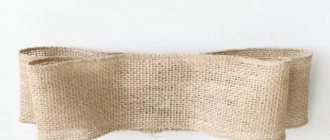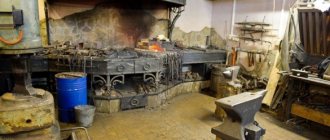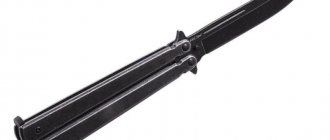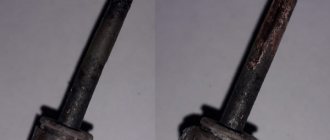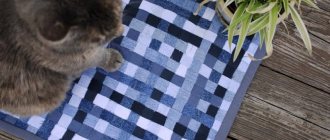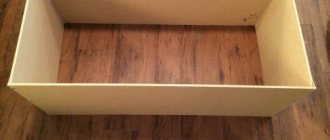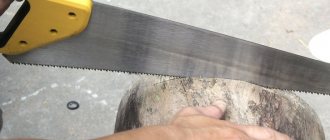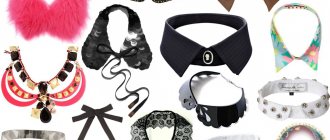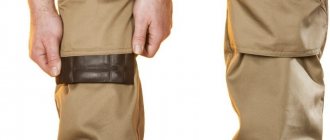I like to make crafts with my own hands. Especially from used items and things. So to speak, breathe new life into them. Wrenches... Over the years, with intensive use, their working edges (jaw) wear out and gradually separate (especially when excessive force is applied to them when unscrewing rusted or overtightened bolts and nuts). It is impossible to use such keys, and it is dangerous (you can damage your fingers); throwing them away is a shame. What to do with them? There is an exit! Make a knife out of him! And what: suitable size (the larger the key number, the longer and more massive the knife will be), high strength and hardness (usually keys are made of chromium or chrome vanadium structural steel grades 40X, 40HF, 40HFA and their foreign analogue AISI 5140). The steel grade is usually indicated on the handle in the form of raised numbers and letters or simply the word “chrome vanadium”. A knife made from a key turns out to be so sharp that you can shave hair with it without any problems, while it is also quite durable, so it is also suitable for chopping branches.
Original knives made from unexpected objects
Famous knife manufacturers are actively trying to convince us that a good and original knife can only be made from high-quality steel, equipped with secret additives. This immediately gives +50 points of corrosion resistance, +100 points of strength and + 500 points of pathos and show-off. Well, that because of this the price rises to mind-boggling heights - that’s true, details. Collectors will buy in any case, otherwise what kind of collectors are they?
Just don’t forget that a knife is first and foremost a tool. Our ancestors made them from some kind of crap iron, if not cast iron, but this did not stop them from actively using such knives.
Go to any cultural museum and you will see knives with obvious signs of wear.
Because you need to work with knives, and not give a damn about the quality of steel and exquisite design, which will come in handy throughout your life.
Seriously, knives can be made from any steel, even from one that has already been used. Some blacksmiths manage to forge things into quite original knives that initially have nothing to do with the concept of “weapon” and “knife”. And we will now show you the results of their creativity.
Knives forged from motorcycle and bicycle chains
These knives look especially beautiful, but due to the structure of the metal, they are not very reliable and durable. But they still cope with their tasks perfectly.
Original knives made of steel cables
Knives made from steel cables are somewhat visually reminiscent of the famous Damascus steel, but not as strong, of course. On the other hand, due to the orientation of the steel fibers, the strength is generally higher than what would be expected from ordinary steel.
Knives made from wrenches
Reforging an old wrench into an original knife is a great idea. Still, normal tool steel is a guarantee of strength and durability.
This knife was reforged from a universal wrench (the photo shows this same wrench for comparison). The knife retains the texture of damask steel, which is poorly visible in the photograph.
- And this old Soviet key, apparently, could not stand the hard work, as a result of which one of the heads broke off, which was then reforged into a cutter.
A knife reforged from a classic gas key. As you can see, the author even preserved the thread and nut.
- A wide variety of wrenches—socket wrenches, socket wrenches, open-end wrenches—can also become a “base” for creating a variety of knives.
- And here the master made an incredibly stylish straight razor from a dialed spanner.
Knives from connecting rods from the engine
Well, everything is quite simple here - a connecting rod is taken from the crank mechanism of an internal combustion engine, and... But it is also quite reliable.
File knives
Knives made from files look really cool, but the blade blade has its pros and cons - it’s better to find out in advance. Overall, very durable, sharp and beautiful.
- And for a “snack” - a knife forged from a bayonet from a Mosin rifle.
Source: https://lastday.club/originalnye-nozhi-sdelannye-iz-neozhidannyh-predmetov/
DIY wrench knife
Home › Knife making
01.10.2019
Knife makers like to make blades from scrap materials for variety. In this article we will tell you how to make a knife from a wrench. The blade will turn out to be decent, because high-carbon tool steel is easy to process and will be obedient during work.
DIY knife made from a wrench.
Materials and tools
The workpiece was selected from 40HFA steel. The alloy includes chromium and vanadium, which makes the workpiece ductile and suitable for making knives. Sharpening the blade will be easy. An error-free hardening process will give the product good hardness. Difficulties in manufacturing are unlikely; the following materials will be required:
- wooden block;
- brass rod with a diameter of 0.3-0.4 mm;
- epoxy glue or similar properties;
- impregnation for wood;
- blank in the form of a key for 30 or more;
- masking tape;
- container with motor oil.
The attentive reader clearly noticed that we are not talking about forging the workpiece. That's right - it is not necessary to forge, the main thing is to accurately harden the steel. The process will consist of cutting and grinding work; a tool will be required of the appropriate nature:
- Grinder angle grinder, set of circles;
- belt sander (ideal);
- marking marker;
- forge or oven;
- vices, tongs, clamps, clamps;
- set of files, needle files;
- drill, drills of different diameters;
- sandpaper with different grains.
The arsenal of tools looks professional, but beginners should not be afraid of this. The belt sander can be easily replaced with a grinder with a grinding wheel. For convenience, placing it in a horizontal position and working is not difficult.
The process of making a knife from a wrench with your own hands
The initial stage of making a knife from a wrench is to find a blank. The old tool may have succumbed to corrosion, then it should be cleaned of rust. An angle grinder with a wire attachment will come in handy here; as an additional option, you need to use sandpaper with coarse grain.
The process of making a wrench.
Main profile cut
The cleaned tool must be marked in accordance with the future blade. A marker will help with this ideally:
- Immediately mark the rise of the blade and the tip. Don't forget about the handle. The workpiece will take on a template marked appearance.
- For reliability, you should go over the marker with a tap, scratching the markings on the key.
- Having clamped the workpiece in a vice, using a grinder with a cutting wheel, we begin to cut off the unnecessary parts of the key.
- Use files or a grinder to remove burrs. It is acceptable to use an angle grinder with a grinding wheel. There are enough options.
Dimensions and markings
The full set contains sizes from 8 to 19 (with the exception of 9).
For those who drive German and French cars, No. 16 and N18 will be very useful.
+ Plus
Each size is marked with its own color.
This is done on both heads and Wera keys. If you often use such a tool, you will be able to instantly select the desired size from the whole heap simply by color.
A very useful and inexpensive feature, which for some reason is not used by other manufacturers.
How to make a wrench knife with your own hands, spending 200 rubles
I like to make crafts with my own hands. Especially from used items and things. So to speak, breathe new life into them.
Wrenches... Over the years, with intensive use, their working edges (jaw) wear out and gradually separate (especially when excessive force is applied to them when unscrewing rusted or overtightened bolts and nuts).
It is impossible to use such keys, and it is dangerous (you can damage your fingers); throwing them away is a shame. What to do with them? A knife made from a key turns out to be so sharp that you can shave hair with it without any problems, while it is also quite durable, so it is also suitable for chopping branches.
For work you will need the following materials:
- 30mm wrench or so;
- wooden blocks (for handle lining);
- brass rods (for pins);
- epoxy adhesive;
- hardening oil;
- polishing paste;
- wood impregnation oil;
- rags, paper napkins.
To carry out the operations you will need tools, processing material and devices:
- belt grinder (grinder);
- endless abrasive belt, sandpaper;
- files for metal and wood;
- Bulgarian;
- drill press or drill;
- marker;
- clamps;
- vice;
- stove based on a gas burner;
- drill;
- scriber;
- metal ruler, etc.
First, you need to put the workpiece in order (we use a wrench). It needs to be cleaned of dirt and rust using a grinder or drill with a wire attachment. Now, on the cleaned surface of the key, using a metal ruler and scriber, it is easier to mark the profile of the knife with a certain tolerance.
This is interesting: Making a pulley from plywood with your own hands
To do this, the workpiece must be securely clamped in a vice. It is better to complete this transition on a grinder in order to bring the transverse profile of the knife blade closer to its final shape.
The following operation is one of the main ones. It is necessary to form the cutting part of the knife - the blade. Using a marker, mark the boundary between the blade and the base of the handle.
Then the blade is clamped into a special holder and excess metal is symmetrically removed from its sides in such a volume as to form a thickness along the entire height of the blade equal to that of the finished knife from above with a small tolerance.
The overlays can be made from birch, beech, maple, cherry, pear, etc. Using a handle as a jig, holes are drilled in the wooden blocks for the pins.
After the glue has dried, the pins are cut flush with the pads and lightly sanded under the surface of the pads. The wood should be impregnated with oil to protect it from moisture and dirt. All that remains is to wipe the knife with a rag, and it is ready for use.
It must be borne in mind that according to GOST 2838-80 “Spanners.
General technical conditions", the hardness of the key handle can be 5 HRCe units less than the lower hardness limit for the jaw (average value 41.5 HRCe).
Case and complete set
They are most often supplied as a set, in a protective nylon case.
+ Plus
This material is very resistant to mechanical stress and in this regard will serve you for quite a long time.
However, do not leave it in direct sunlight for a long time.
- Minus
Over time, due to exposure to ultraviolet radiation, the case may acquire a completely unpresentable appearance.
For hanging on a nail, there is a grommet in the center of the case and a loop on the side.
You can use it to carry your keys on your belt.
The entire set is rolled up into a compact size and closed with Velcro.
Another Velcro is located in the center of the case on the back side.
- Minus
When you unroll the fabric on your workbench, you will collect all the dust and dirt on it.
The keys themselves are packed in mesh pockets.
Making a knife from an old wrench
As some blacksmiths and craftsmen say: “No matter how many knives you make, it still won’t be enough.” And really, why waste time on trifles? We bring to your attention another very interesting version of a homemade knife, and this time we will make it from an old wrench. Why not? Moreover, a hammer and anvil are not required.
Blade from a key: main stages of work
We make markings on the surface of the wrench and cut out the knife blank with a grinder. Next we process the blade on a belt sander. The work ahead will be long, so it will be a good idea to be patient.
First, we remove the burrs and irregularities that remained after cutting with a grinder, and then we grind the surface of the blade, forming slopes and the cutting edge. The handle of the knife in this case will be metal, so we try not to “cut off” the tail part too much by grinding.
After machining, the blade must be hardened - to do this, heat the knife blade red-hot in a muffle furnace and lower it into a container with oil. Then we begin finishing by hand using fine sandpaper. The inscriptions on the wrench can be removed using a drill.
The final stage and the finished result
At the last stage of work, all that remains is to sharpen the cutting edge of the knife and polish the surface. The result was a very nice homemade blade, made “cold”, that is, without the use of hot forging. The step-by-step process can be seen in the video on the website.
Rate this post
Source: https://sdelairukami.ru/izgotovlenie-nozha-iz-starogo-gaechnogo-klyucha/
Modern sharpener options
In addition, there are more effective, but much more expensive sharpening options. For example, there are special abrasives that are sold in the form of grains that fill one or another container (most often a glass or decanter) and the knife is sharpened when placed/dipped into such a container. An interesting option, but such purchases are quite expensive.
It is possible to buy Chinese sharpeners, which consist of abrasive wheels attached to the handle. Also a good option, inexpensive and convenient, you don’t need to maintain an inclination, the only problem is that the quality and service life of such a device are extremely low. Simply put, the purchase will not last long and then you will need to purchase a new sharpener, albeit not an expensive one.
Is it possible to find something optimal in this diversity? As you know, if you want something, you need to do it yourself. This is exactly the case with a knife sharpener. It is possible to take the design of Chinese sharpeners, but use more durable parts and make your own inexpensive but high-quality option.
How to make a master knife from a wrench
Hello! Today I would like to introduce a pick knife from a number 32 wrench. It’s quite simple to make, just sharpen it from a key using a sharpener or a grinder. What can it be useful for? This will be discussed further.
The thickness of the pick knife (about 8 mm) and chrome vanadium alloy provide it with unusual strength. They can act as a lever to open, for example, an intercom door when there is no key, as well as to unscrew weak hinges of padlocks.
The chisel-shaped end can be used to split and knock out the cylinders of brass locks with a simple key.
The sharpening of the pick knife is intermittent. Towards the end, the angle increases sharply so that when used as a lever, it does not spoil the sharpening again.
A pick knife can also be driven into ice, into various crevices, etc., tied to a ring and used as a climbing crutch; it can easily withstand the weight of a person, and probably more than one.
You can also plan with the blade of a pick knife; the tip can be used as a chisel. Only for this purpose it is necessary to first beat off the edges of the blade, because...
The chrome vanadium steel of the key itself is quite soft, and after hardening its hardness doubles. This knife can also hit like a club.
The handle can be carved to suit your taste and hand, wrapped with rope and leather, but for now it seems to me unnecessary to do anything with it, but we’ll see.
A pick knife is not considered a cold knife, because it is a knife not designed for stabbing due to its thickness and the angle of the tip. And not a baton, with a pronounced striking part. In general, you can also make a good bayonet-knife, samurai dagger, etc. from a wrench, your imagination will tell you what to do next.
Andrey Galkin
PS
As you can see, dear friends, Andrey again showed us that, if desired, knives can be made from anything and any kind. That is, the concept of “knife” in this article goes beyond the scope of classical specialization.
The knife was configured for a completely different use than just cutting and stabbing.
I hope we will see more of his original ideas in the field of making bladed weapons and he, as an expert in his field, will help beginning home-made craftsmen with good advice in technical matters.
Admin
Source: https://sekach.ru/samodelnoe_oruchie/nohg-otmychka
Ratchet
Wera Joker combination wrenches have a ratchet on the reverse side.
It is one-sided, without reverse. To turn it in the other direction you will have to turn the key over.
There are, however, other sets that have a built-in flag switch.
But they cost quite a lot of money.
This ratchet has 80 teeth, the tooth “jumping” angle is only 4.5 degrees.
